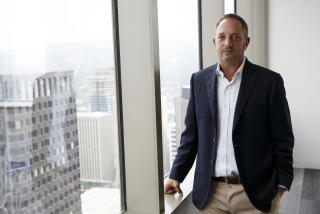Enron Prosecutors Cite Pattern of Deeds by Lay
- Share via
HOUSTON — In a glimpse of their strategy for the January trial of former Enron Corp. Chairman Kenneth L. Lay, federal prosecutors are seeking to use evidence that allegedly shows that Lay helped “whitewash” a 1987 scandal in which a pair of traders inflicted heavy losses on the energy company.
That incident demonstrates a pattern of behavior by Lay that was strikingly similar to his actions during the events that led up to Enron’s 2001 collapse under the weight of an accounting scandal, the prosecutors said in papers filed in U.S. District Court here Friday.
In early 1987, Enron discovered that two top executives at Enron Oil Corp. in Valhalla, N.Y., had defrauded the company by diverting funds and shifting profit from the previous year.
But Lay, then Enron’s chief executive, “urged the board of directors not to fire the executives because ‘they made too much money for Enron,’ ” according to the documents.
Later that year, the company discovered that the two executives, Enron Oil President Louis J. Borget and Secretary-Treasurer Thomas N. Mostroeni, were violating internal trading limits that had been established to minimize losses. They made bad bets on the direction of oil prices, costing Enron $85 million after taxes, which erased half of its profit for the year.
Lay denounced both men in October 1987 as “rogue oil traders” and attempted “to portray himself as a stunned chief executive officer who had only recently learned of the violations by persons he never would have suspected,” the filing said.
Borget and Mostroeni pleaded guilty in 1990 to fraud and tax-evasion charges.
Borget served a year in jail, and Mostroeni was put on probation for two years and ordered to complete 400 hours of community service.
In their court filing, prosecutors allege that 1987’s chain of events was repeated in 2001 when Lay publicly backed Enron’s then-Chief Financial Officer Andrew M. Fastow despite warnings that Fastow’s alleged financial manipulations were endangering the company.
When it was revealed how Enron had used the complex off-the-books accounting schemes to inflate its financial results, the country’s seventh-largest corporation imploded and filed for bankruptcy protection. About 6,000 employees lost their jobs and their retirement savings.
But Lay has placed all of the blame on Fastow, who has pleaded guilty to fraud-related charges and has agreed to cooperate with the Justice Department’s Enron Task Force in exchange for a 10-year prison sentence and the payment of nearly $30 million in restitution.
“In both years, Lay authorized Enron to take extraordinary and unusual risks with top executives, only to deny knowledge of key facts and misrepresent his complicity later in order to assuage Enron employees and the marketplace,” the filing alleged.
Prosecutors want the court’s permission to use information about the 1987 incident during Lay’s trial.
Lay is scheduled to go to trial alongside Jeffrey K. Skilling, Enron’s former chief executive, and Richard A. Causey, the Houston-based company’s former chief accounting officer.
Lay has pleaded not guilty to four counts of securities fraud, three counts of making false statements to banks, two counts of wire fraud and one count each of bank fraud and conspiracy to commit securities and wire fraud.
Lay’s attorney, Michael Ramsey, didn’t respond Friday to phone messages. The Justice Department had no immediate comment.
More to Read
Inside the business of entertainment
The Wide Shot brings you news, analysis and insights on everything from streaming wars to production — and what it all means for the future.
You may occasionally receive promotional content from the Los Angeles Times.










